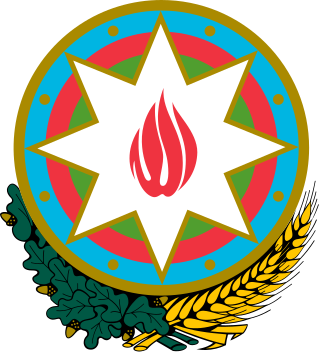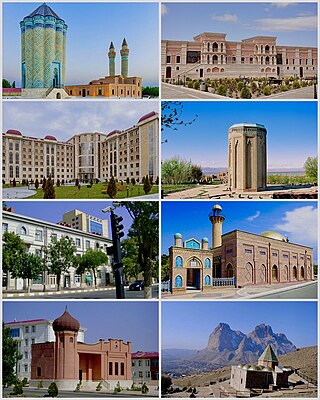
Azerbaijan, officially the Republic of Azerbaijan, is a transcontinental and landlocked country at the boundary of Eastern Europe and West Asia. It is a part of the South Caucasus region and is bounded by the Caspian Sea to the east, Russia's republic of Dagestan to the north, Georgia to the northwest, Armenia and Turkey to the west, and Iran to the south. Baku is the capital and largest city.

The Republic of Azerbaijan is a member of the United Nations, the Non-Aligned Movement, the Organization for Security and Cooperation in Europe, NATO's Partnership for Peace, the Euro-Atlantic Partnership Council, the World Health Organization, the European Bank for Reconstruction and Development; the Council of Europe, CFE Treaty, the Community of Democracies; the International Monetary Fund; and the World Bank.

Azerbaijanis, Azeris, or Azerbaijani Turks are a Turkic ethnic group living mainly in the Azerbaijan region of northwestern Iran and the Republic of Azerbaijan. They are predominantly Shia Muslims. They comprise the largest ethnic group in the Republic of Azerbaijan and the second-largest ethnic group in neighboring Iran and Georgia. They speak the Azerbaijani language, belonging to the Oghuz branch of the Turkic languages.

Nakhchivan is the capital and largest city of the eponymous Nakhchivan Autonomous Republic, a true exclave of Azerbaijan, located 450 km (280 mi) west of Baku. The municipality of Nakhchivan consists of the city of Nakhchivan, the settlement of Əliabad and the villages of Başbaşı, Bulqan, Haciniyyət, Qaraçuq, Qaraxanbəyli, Tumbul, Qarağalıq, and Daşduz. It is spread over the foothills of Zangezur Mountains, on the right bank of the Nakhchivan River at an altitude of 873 m (2,864 ft) above sea level.

The Khojaly massacre was the mass killing of Azerbaijani civilians by Armenian forces and the 366th CIS regiment in the town of Khojaly on 26 February 1992. The event became the largest single massacre throughout the entire Nagorno-Karabakh conflict.

The Assyrian diaspora refers to ethnic Assyrians living in communities outside their ancestral homeland. The Eastern Aramaic-speaking Assyrians claim descent from the ancient Assyrians and are one of the few ancient Semitic ethnicities in the Near East who resisted Arabization, Turkification, Persianization and Islamization during and after the Muslim conquest of Iraq, Iran, Syria and Turkey.

The Kurdish population is estimated to be between 30 and 45 million. Most Kurdish people live in Kurdistan, which today is split between Iranian Kurdistan, Iraqi Kurdistan, Turkish Kurdistan, and Syrian Kurdistan.

The First Nagorno-Karabakh War was an ethnic and territorial conflict that took place from February 1988 to May 1994, in the enclave of Nagorno-Karabakh in southwestern Azerbaijan, between the majority ethnic Armenians of Nagorno-Karabakh backed by Armenia, and the Republic of Azerbaijan with support from Turkey. As the war progressed, Armenia and Azerbaijan, both former Soviet republics, entangled themselves in protracted, undeclared mountain warfare in the mountainous heights of Karabakh as Azerbaijan attempted to curb the secessionist movement in Nagorno-Karabakh.

The Nagorno-Karabakh conflict is an ethnic and territorial conflict between Armenia and Azerbaijan over the region of Nagorno-Karabakh, inhabited mostly by ethnic Armenians until 2023, and seven surrounding districts, inhabited mostly by Azerbaijanis until their expulsion during the 1990s. The Nagorno-Karabakh region was entirely claimed by and partially controlled by the breakaway Republic of Artsakh, but was recognized internationally as part of Azerbaijan. Azerbaijan gradually re-established control over Nagorno-Karabakh region and the seven surrounding districts.

The Nagorno-Karabakh Autonomous Oblast (NKAO) was an autonomous oblast within the Azerbaijan Soviet Socialist Republic that was created on July 7, 1923. Its capital was the city of Stepanakert. The majority of the population were ethnic Armenians.
There are memorials around the globe dedicated to the Azerbaijani victims of the Khojaly massacre — mostly civilians, but also armed troops — by local irregular Armenian forces and the 366th CIS regiment in the town of Khojaly on 26 February 1992.
Currently, there are more than 200,000 Azerbaijanis in Germany. About 17,000 of them live in the capital city of Berlin. The majority of Azerbaijanis work in the field of service and construction. The minority of Azerbaijanis are involved in state structures, universities and hospitals. There are no compact settlements of Azerbaijanis in Germany.
Azerbaijani Canadians are Canadian citizens and permanent residents of ethnic Azerbaijani background, or those who were born in Azerbaijan. Most Azerbaijani-Canadians have immigrated to Canada from the Republic of Azerbaijan, Iran, Russia or Turkey.
Armenian populations exist throughout the world. Although Armenian diaspora communities have existed since ancient times, most of the Armenians living outside of Armenia today are either descendants of Armenian genocide survivors or more recent immigrants from post-Soviet Armenia. According to various estimates, the total number of ethnic Armenians in the world is approximately 11 million, a majority of whom live outside of Armenia.
A rally commemorating the twentieth anniversary of the 1992 massacre of Azerbaijani civilians and armed troops by local irregular Armenian forces and the 366th Commonwealth of Independent States Guards Motor Rifle Regiment took place in Istanbul on 26 February 2012. It was the largest campaign within "Justice for Khojaly" framework. The demonstration with slogan "We are all from Khojaly" started in front of Galatasaray High School and lasted several hours in Taksim Square with around 200,000 participants.

The Georgian diaspora refers to both historical and present emigration from Georgia. The countries with the largest Georgian communities outside Georgia are Turkey and Russia. The Georgian diaspora, or the dispersion of Georgian people outside of Georgia, began to take shape during various historical periods. However, a significant wave of emigration occurred during the 19th and 20th centuries, particularly during times of political upheaval, such as the Russian Empire's expansion into the Caucasus region and the Soviet era.
Azerbaijanis in France is a small Azerbaijani diaspora in France, are French citizens and permanent residents of ethnic Azerbaijani background. Most Azerbaijani-France have immigrated to France from the Republic of Azerbaijan and Iran.
Azerbaijanis in the United Kingdom or Azerbaijani Britons are a small Azerbaijani diaspora in the United Kingdom, including British citizens and permanent residents of ethnic Azerbaijani background.
The Khojaly massacre was the mass killing of at least 161 Azerbaijani civilians by Armenian forces and the 366th CIS regiment in the town of Khojaly on 25 February 1992. It has been recognized and commemorated by acts adopted in fifteen countries and in 28 U.S. states.
Azerbaijani populations exist throughout the world. About 8.2 million Azerbaijanis live in Azerbaijan, making 91.6% of the country's population. According to the CIA website, Azerbaijanis are the second ethnic group in Georgia and in Iran.












